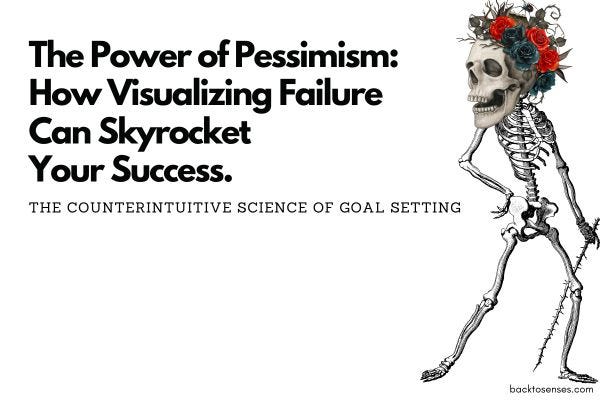The Power of Pessimism: How Visualizing Failure Can Skyrocket Your Success. Part 1.
The Counterintuitive Science of Goal Setting
"Visualize your success," they say.
"Imagine it so vividly that you can taste it, touch it, smell it."
In the bright and sugar-coated universe of motivational speak, the notion of positivity is handed out like candy at Halloween—pleasing, yes, but often failing to satiate the deep, burning hunger for real results.
But what if I told you that the rocket fuel propelling you toward your loftiest goals may very well be the power of negativity?
Yes, you read that correctly.
Negativity, that unsung hero that has been unjustly overshadowed by its sunnier counterpart.
The Counterintuitive Science of Goal Setting
Conventional wisdom tells us to aim high and visualize success.
But according to Andrew Huberman, there's more to the story:
Frequently visualizing failure can double your chances of achieving your goals.
Surprising? Maybe.
Effective? Absolutely.
Why Failure Should Be Your New Best Friend
The science is in, and it's compelling.
Visualizing failure does more than just prepare you for potential pitfalls; it actively drives you toward success.
It's not just about avoiding the bad; it's about channeling the fear of failure into a constructive force.
Here's what happens:
Nearly double the chance of reaching any goal, be it weight loss or career progression.
A surge in motivation that propels you forward.
An overall increase in the likelihood of achieving what you're after.
How the Brain Gets on Board
It turns out that the amygdala, that tiny part of your brain often maligned for its role in anxiety and fear, is a key player in goal pursuit.
When you consider what could go wrong—health setbacks, career disappointments, etc.—your amygdala kicks into high gear, improving your focus and determination.
Get Specific: The Devil's in the Details
Want to boost your chances of success even further?
Get specific about what failure looks like.
Whether you write it down or talk it out, the more detailed you get, the better.
Specificity acts like a magnifying glass for your intentions, making your objectives clear and your pathways to achieve them more apparent.
More Than Just Mental: The Body Joins the Fight
Visualizing failure isn't just a psychological trick; it has physiological effects too.
Expect to see an increase in systolic blood pressure, an indicator that your system is ready and alert.
Your body, it seems, is as committed to avoiding failure as your mind is.
Why Negative Beats Positive: The Brain's Bias
Neuroscience tells us that our brains are wired to prioritize avoiding negative outcomes over pursuing positive ones.
This is due to the phenomenon of "one-trial learning," where a single negative experience can rewire your neural pathways to prevent similar future disasters.
The Balanced Approach: Not All Doom and Gloom
While the data suggests that thinking about failure is generally more beneficial, that doesn't mean you should never envision success.
Positive visualizations, like imagining acing an exam, have their place.
The key is to use them judiciously, balancing them with a more prevalent focus on avoiding failure.
Don't Go Overboard
While it's clear that visualizing failure can be an effective tool, there's a fine line between constructive visualization and self-flagellation.
The aim is to spur yourself into action, not to engage in mental self-torture.
So the next time you're setting your sights on a lofty goal, go ahead and think about what could go wrong.
Visualize the failures, disappointments, and setbacks.
Then use those vivid, somewhat unsettling images as fuel to defy the odds and turn potential failure into resounding success.
Still don’t feel like doing it?
Think again.
"The secret of getting ahead is getting started. The secret of getting started is breaking your complex overwhelming tasks into small manageable tasks, and starting on the first one." -Mark Twain
I'm creating a course for Ambitious Procrastinators Creative Solopreneurs, who are brimming with ideas, but lacking in execution.
To move you stuff from your 'one day' pile to 'day one' and then 'done'.
get clarity
manage procrastination
resistance, overthinking
develop bias toward action
manage distractions
Subscribe now and get a front row access when it’s ready!
BACKTOSENSES’s Newsletter is a reader-supported publication. To receive new posts and support my work, consider becoming a free or paid subscriber.


